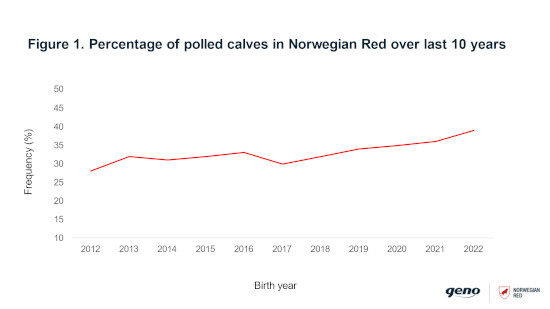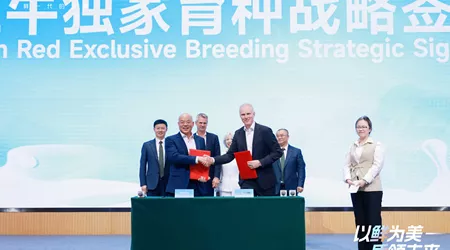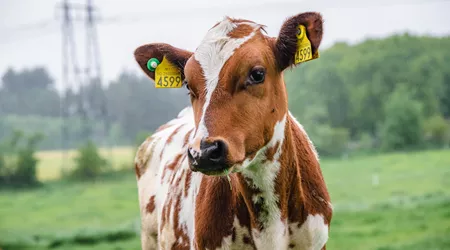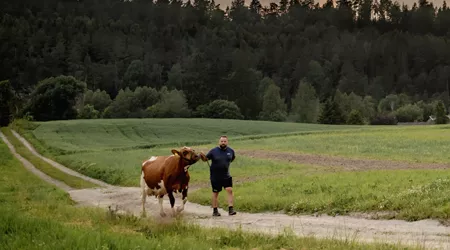By Gary Rogers
The welfare benefits are likely to be more important in the future, as consumers have more impact on dairy production practices. The economic benefits of polled depend somewhat on the local regulations and requirements for dehorning, but direct costs of dehorning may not be nearly as important as indirect costs associated with dehorning. Dehorning increases the risk of calf health problems and impacts calf performance for key traits.
Milk procurement and processing companies continue to add new management specifications for their suppliers in some countries. In other countries, herd audits provide higher ratings for management practices like the use of polled animals. Polled dairy cows could become a requirement for some milk markets or milk companies in the near future. The addition of polled genetics should become a best practice for many herds as polled genetics enhances worker safety and shows continual improvement in animal welfare which is very positive for the dairy industry.
Increased frequency of polled in Norwegian Red
The dairy industry has discussed the benefits of polled cattle for many decades but dramatic increases in polled frequencies have eluded most dairy populations. This contrasts with global beef cattle populations where many commercial beef cattle populations have benefitted from polled cattle for many decades.
Access to high merit polled sires and potential inbreeding concerns have hampered the movement to polled in most key dairy cattle populations. However, some populations like the Norwegian Red (NR) have successfully increased the frequency of polled and, very recently, the percentage of top Holsteins sires that are polled has increased. Norwegian Red has always been a world leader in the frequency of polled and that continues today.
Frequency of polled in Norwegian Red
The frequency of polled calves in NR is detailed in Figure 1. This provides the overall picture for polled in NR but perhaps more importantly is the polled frequency in recently marketed sires. Geno has marketed over 300 NR sires globally over the last 10 years. Out of these sires sold internationally, 9% have been PP (homozygous polled), 33% Pp (polled), and 58% horned.

For many years polled was managed primarily through favoring polled offspring in selection decisions from sires and dams that were polled. However, in recent years the increase in polled frequency across the population was not adequate to meet the goal of the breeding program for polled, so polled was added directly as a part of the Total Merit index (TMI). Polled now gets 5.3% of the weight in the NR TMI and polled is now expected to increase at a much faster rate than in the past.
Current homozygous polled (PP) sires available in global market
The bulls listed here are all homozygous polled and A2A2 for beta casein. These bulls are available in many markets. Some bulls on the list may not be in all markets but they could be available soon.
Aland-PP (252NR12139) – Very good all-around sire, well-balanced trait profile, excellent fat and protein percentages, excellent for heifer matings, unique and rare profile: PP, A2A2, and BB for kappa casein
Barup-PP (252NR12085) – Good solids production, outstanding daughter fertility and health, A2A2
Hauen-PP (252NR12136) – Well-balanced trait profile, excellent udder health and daughter fertility, good fat and protein yield, udder conformation and Feed$aved, excellent for heifer matings, A2A2
Maurstad-PP (252NR12009) – Very good all-around sire, very high component percentages, excellent overall daughter health, very good udder and feet and legs conformation, very good for heifer matings, A2A2
NR Fallmyr-PP (252NR12203) – Very good all-around sire, excellent overall daughter fertility, very good udder and feet and legs conformation, very good for heifer matings, excellent for Feed$aved, A2A2
NR Skjefstad-PP (252NR12188) – Very good solids yield, very good udder conformation, excellent claw health, very good for heifer matings, very good for Feed$aved, A2A2
NR Tornes-PP (252NR12201) – Excellent all-around sire, high component percentages and excellent solids yield, excellent overall daughter health, very good udder and feet and legs conformation, very good for heifer matings, very good for Feed$aved A2A2
Oaland-PP (252NR12093) – Good all-around sire, well-balanced trait profile, excellent daughter fertility, good udders, good for heifer matings, very good for Feed$aved, A2A2
Sausvatn-PP (252NR12116) – Excellent solids yield with very high fat and protein percentages, excellent for heifer matings, excellent for Feed$aved, good udder health, daughter fertility and udders, A2A2
Current heterozygous polled (Pp) sires available in global market
In addition to the homozygous polled sires, many heterozygous polled sires are actively being sold internationally. Dairy producers should check with their local NR semen supplier for the availability of polled bulls. Many producers may be interested in some of these Pp sires.
Fossesholm-P (252NR12163) – Very good all-around sire, very good solids yield, udder health, udder conformation, feet and legs conformation and claw health, BB for kappa casein
Hagemoen-P (252NR12114) – Outstanding milk, fat and protein yield, very good udder health, udder conformation, small daughters that are outstanding for Feed$aved, A2A2, AB for kappa casein
Jo-Onstad-P (252NR12064) - Very high solids yield, excellent udders, not for heifer matings, A2A2
NR Draugsvoll-P (252NR12195) – Very high solids production, outstanding udder conformation and very good udder health, very good for claw health, black coat color/red carrier, A2A2
NR Hasselberg-P (252NR12202) – Tremendous milk, fat and protein yields, excellent udder conformation and very good udder health, very good for Feed$aved, excellent for heifer matings, A2A2
Ofstad-P (252NR11919) – Daughter proven, very high solids yield, outstanding udder health and tremendous daughter fertility, one of top bulls for Feed$aved, very good claw health, outstanding for heifer matings, A2A2
Significant economic and welfare benefits
Polled dairy cattle provide significant economic and welfare benefits. Dairy producers and the dairy industry should pursue polled dairy cattle with more intensity.
Norwegian Red has historically had the highest frequency of polled animals among the major dairy breeds, and this Norwegian Red advantage continues today. Many top Norwegian Red sires are polled and these sires can be readily used in crossbreeding programs.
Homozygous polled sires will create all polled offspring in the next generation so herds can quickly convert to a polled herd. Some Holstein populations have placed more emphasis on polled recently so the opportunity to use polled Holstein sires has improved in recent years. The use of these polled Holstein sires in a crossbreeding program along with the polled Norwegian Red sires can eliminate the need for dehorning in the future.



